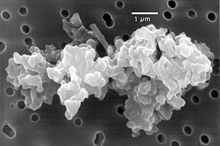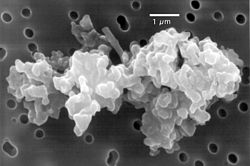Kosmischer Staub

Kosmischer Staub ist Staub im Weltraum. Je nach seinem Ort bzw. Ursprung unterscheidet man
- intergalaktischen Staub
- interstellaren Staub
- interplanetaren Staub (der auf der Erde als Zodiakallicht sichtbar sein kann)
- zirkumplanetaren Staub, etwa in Planetenringen.
Zum kosmischen Staub zählen auch die Wasservorkommen im Universum in Form von fein verteiltem Wassereis (siehe auch Wassersynthese im Weltraum).
Die Erde fängt pro Jahr etwa 30.000 Tonnen kosmischen Staubs ein, der überwiegend interplanetarer Staub ist. Die insgesamt eingefangene kosmische Materie (mit Gasen) variiert zwischen etwa 150.000 und 1.000.000 Tonnen pro Jahr.[1]
Siehe auch
Literatur
- Genzel R & Cesarsky CJ, Extragalactic Results from the Infrared Space Observatory, Annual Review of Astronomy and Astrophysics 38: 761–814, 2000
- J. Binney & M. Merrifield, Galactic Astronomy (Princeton Series in Astrophysics), 1998
- D. C. B. Whittet, Dust in the Galactic Environment (Graduate Series in Astronomy)
- Mayo J.Greenberg: The cosmic dust connection.Kluwer, Dordrecht 1996, ISBN 0-7923-4365-4
- Gorden Videen: Optics of cosmic dust. Kluwer, Dordrecht 2002, ISBN 1-4020-0819-8
- Edmond Murad, Iwan P. Williams: Meteors in the earth's atmosphere - meteoroids and cosmic dust and their interactions with the earth's upper atmosphere. Cambridge Univ.Press, Cambridge 2002, ISBN 0-521-80431-0
Weblinks
Einzelnachweise
- ↑ Bernd Herrmann: Beiträge zum Göttinger Umwelthistorischen Kolloquium 2009 - 2010. Universitätsverlag Göttingen, 2010, ISBN 978-3-941875-52-4, S. 110 (books.google.de).
Auf dieser Seite verwendete Medien
Autor/Urheber: Der ursprünglich hochladende Benutzer war Amara in der Wikipedia auf Englisch, Lizenz: CC BY 1.0
This is a scanning electron microscope image of an interplanetary dust particle that has roughly chondritic elemental composition and is highly rough (chondritic porous: "CP"). CP types are usually aggregates of large numbers of sub-micrometer grains, clustered in a random open order. The authors of this figure are Donald E. Brownlee, University of Washington, Seattle, and Elmar Jessberger, Institut für Planetologie, Münster, Germany.
This file is licensed under Creative Commons Attribution 2.5 License: https://creativecommons.org/licenses/by/2.5/ See the (Jessberger chapter in Grün, E., Gustafson, B.A.S., Dermott, S.F., Fechtig, H. (Eds.) Interplanetary Dust book for more details on this kind of dust particle.
References
- E. K. Jessberger, T. Stephan, D. Rost, P. Arndt, M. Maetz, F. J. Stadermann, D. E. Brownlee, J. P. Bradley, G. Kurat (2001). Properties of Interplanetary Dust: Information from Collected Samples, in Grün, E., Gustafson, B.A.S., Dermott, S.F., Fechtig, H. (Eds.) Interplanetary Dust, pp. 253–294, Springer-Verlag.
